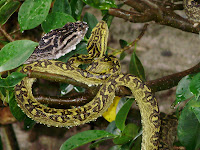
 What a day, what a week! Halloween started with a carnival on the base on the 25th. Danny went with his friend, Liam, and had a blast. Bouncy houses, games, prizes, candy, food, a haunted house -- everything a child could hope for.
What a day, what a week! Halloween started with a carnival on the base on the 25th. Danny went with his friend, Liam, and had a blast. Bouncy houses, games, prizes, candy, food, a haunted house -- everything a child could hope for.

Halloween itself was even more exciting because there was no school! In our neighborhood: We were not sure whether our not the Japanese children in our neighborhood were familiar with the American tradition of trick-or-treating. So, we decided to do "reverse trick-or-treating" in order to share our American custom with them. Danny and I made goodie bags filled with American candies (M&Ms, Dove chocolates, gummies, Jolly Ranchers, etc.) along with this note: ハッピーハロウィーン! ご 家 族 か ら の Repasy 。
(It says "Happy Halloween from the Repasy Family" in Japanese -- we used Google Translate to do this) and delivered them to all of the houses in our neighborhood. In the typical Japanese tradition of always returning gifts, when we returned to our house later in the evening, many goodie bags filled with candy were left for Danny on our doorstep! Our neighbors are too nice. Between our neighbors and trick-or-treating, we have enough candy to last us for a year (Danny already gave me all of his Snickers since he doesn't like things with nuts in them).
Halloween Night!
We attended two (yes, two) parties AND went trick-or-treating! Ric's command (NAVFAC Far East) sponsored a Halloween party for the Shunko Gakuen children's home (a local orphanage for older children). It was really wonderful to take these children trick-or-treating on the base and then to share a party with them. The children were all very polite and so excited to get to partake in Halloween activities. They couldn't help but eat their candy while we were trick-or-treating even though we tried to explain that there was TONS of food waiting for them at the party to be held afterwards (and was there ever -- pizza, fried chicken, hot dogs, traditional Japanese foods, cookies, cakes, candies, etc. -- so much food my tummy hurts just thinking about it).

Danny and I left the command party a little early so that he could attend another party that his friend Kyler was having. Kyler's mom, Stacie, is SUPERWOMAN! Not just for Halloween but each and every day. Stacie is the mother of two and has another baby coming soon. She receives a direct supply of energy from God (there is no other explanation for her never-ending energy, kindness, and good-nature). Danny and his friends "bobbed" for apples (hence the wet hair in the photo below!), played endless number of games, loved each other, and never wanted the evening to end. It was a wonderful evening.
 From our house to yours, Holidays Omedeto Gozaimasu!
From our house to yours, Holidays Omedeto Gozaimasu!  Our tree is decorated with candy canes and Japanese washi eggs. Japanese washi is handmade paper made from wood bark. Each washi egg is also made by hand. The washi is intricately decorated, extremely colorful, and beautiful.
Our tree is decorated with candy canes and Japanese washi eggs. Japanese washi is handmade paper made from wood bark. Each washi egg is also made by hand. The washi is intricately decorated, extremely colorful, and beautiful.



































 We spent a day doing recreational activities at White beach.
We spent a day doing recreational activities at White beach.









